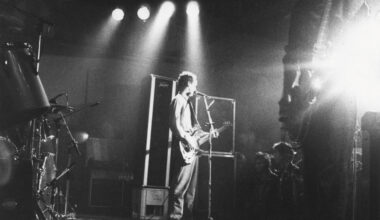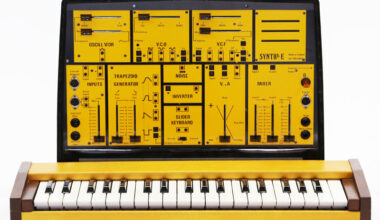Beastie Boys’ cohort, in-house carpenter, and all-round keyboard whiz Money Mark has created a 21st century player piano that converts holes in paper rolls into MIDI data. Mark’s Keyboard Repair indeed
Somewhere in the interval between the Fartbarf gig and Daniel Miller’s Eurorack set, there are ramen noodles – bushels of them. Crowded into a small, izakaya-style Japanese pub in the heart of Durham, North Carolina, are loads of Moogfest attendees bent over bowls of steamy hot broth. The slurp factor here is condoned and thus extremely high. And muscled in between the locals and the festival-goers is Mark Ramos Nishita, aka Money Mark. The difference between the 59-year-old musician and everyone else who has overrun this tiny trough is that, by meal’s end, Money Mark will probably have worked out a way to make a rhythm box out of his kushiyaki skewers and sake cup.
Known for his long-standing connection to the Beastie Boys crew, Money Mark is one of the West Coast’s great utility players – a Los Angeles-based touring keyboardist who’s done his fair share of soundtrack and solo work, and who’s also seen as a major asset in the studio. As he wanders around the 2019 Moogfest, he looks every inch the crafty potterer that he is. Particularly since he’s toting around a portable radio that he’s managed to wire up to a telegraph key in order to generate staticky beats from the airwaves. Experimentation is at the heart of a lot of what he does.
“If you’re a curious person and just trying to solve a problem, boredom is a moment when your internals are just working on it,” he says. “I don’t consider it to be a bad thing. It’s kind of cool actually. When we were recording back in the day, sometimes the tape would run out and someone would have to go out and get a new one. So, we had time. We were either going to improve our song, or bond as a band some more. That was also a time when we could tinker and say, ‘Let’s put thicker strings on the guitar or something!’.”

The reason Money Mark has turned up at Moogfest is to demonstrate his Echolodeon – an electronic/pneumatic instrument that he has retooled in order to resurrect ancient, player piano rolls.
“The player piano is really easy to understand,” he explains. “It’s very linear. But at the same time, it’s basically a computer. The paper roll is the software and the piano is the hardware.”
By converting the holes in the paper into MIDI signals, which can then be played by a modern-day keyboard, the Echolodeon is a 21st century steampunk fancy that actually exists beyond the realm of a fantasy convention.
Money Mark’s first contact with what was once called a “pianola” came circa 2012.
“When Adam Yauch had passed – rest in peace – I kinda felt like I needed to change everything, so I opened up my toolshed. And at the exact same time, I acquired three broken player pianos from a friend. The whole time I had the PianoBar, which was the Don Buchla/Bob Moog collaboration. And after I had fixed one of the player pianos, I jumped out of my chair when I realised that I could put the PianoBar on it and make the piano roll play through my polysynth!”
Onstage at the Carolina Theatre earlier that day, Money Mark had filled the hall with billowing clouds of electronic sound as the thin, perforated paper slid silently through his instrument. It is not, however, a plug and play operation. The Echolodeon’s creator bends over the device, manipulating the speed of the roll and affecting the performance. The vibe shifts from beautiful to the edge of eerie and back again but, far from a gimmicky marriage of 19th and 20th century tech, to Money Mark the project was revelatory.
“I can put that roll on my machine and introduce Claude Debussy to Dr Robert Moog,” he says.
Since 99 per cent of the audience have never seen a player piano, it’s a bit of mystery how he has pulled all this off.
“There’s an actual bellow that you fill with air and it expands. It’s shaped in an ‘X’ form and the other side of the bellow is creating a vacuum and the pressure from that vacuum is pulling. It pulls air all the way from the tracker where the paper roll is going to sit. When a hole goes by the tracker bar, air flows through it and it moves a valve inside. What I’ve done, is captured the movement of the valve with a pressure switch and that informs a MIDI note.”
The paper rolls that drive the sound come in two flavours – pop songs of the day and those rolls that captured performances of musicians. Once he had the Echolodeon functioning, finding material was a specialised pursuit.
“I acquired a few rolls, and then right away I learned that there were reproduction rolls of composers who performed their own music. Stanford does a good job of archiving them. There are Claude Debussy rolls that exist in the USC special collections that I was able to visit. I put on gloves and pulled them out. No one had seen them in decades. So I started collecting these art rolls and the first one I got was Eubie Blake’s ‘Memories Of You’. His actual performance. And I got the chills. I put it on and played it through one of my polysynths and I just couldn’t believe it was happening.”

Money Mark has broken down the guts of the Echolodeon and separated it into four portable parts, which he can take on the road with him fairly easily. Originally, musicians could capture their performance on the device by playing the keyboard and having their work etched onto a virgin roll of paper with small pencil marks.
“Then they would take the paper out and cut those holes. Gershwin’s main job when he was a kid was making piano rolls from popular songs. And then he started embellishing. And since that was his job, he learned the arrangements of hundreds of songs, and the architecture. Then he started realising the alternate voicings that he could do. He got in trouble for embellishing, but that’s how he got famous.”
These days, Money Mark works with a software engineer called Jeff Feddersen who can reverse-engineer new performances onto the paper rolls.
“He has a laser cutter, so I send him a MIDI file and he can make a roll,” he explains.
Before he moves onto other musical terrain, Money Mark, who can be seen alongside Bob Moog in the 2004 documentary about the genius instrument maker, has a special project in mind for the Echolodeon.
“I would like to do one album where Claude Debussy plays the Moog synthesiser. Kind of a cousin to ‘Switched-On Bach’, but in this case it will be the actual composer’s performance playing through the Moog. I’m going to extract a MIDI file from the Debussy rolls and then hand those to different people to program their own version. I’ll just send them the MIDI file and a Moog One.”
He’s also planning to release an open source paper on how others can build their own Echolodeon in the hopes of furthering the conservation of these piano rolls and the lost performances some of them hold.
“Bob would say, ‘When I make a machine, I’m really putting my soul into it’. I’d rather have more machines made to preserve these rolls, because otherwise they’re just ending up in the trash.”
For more about the Echolodeon project, visit echolodeon.com






